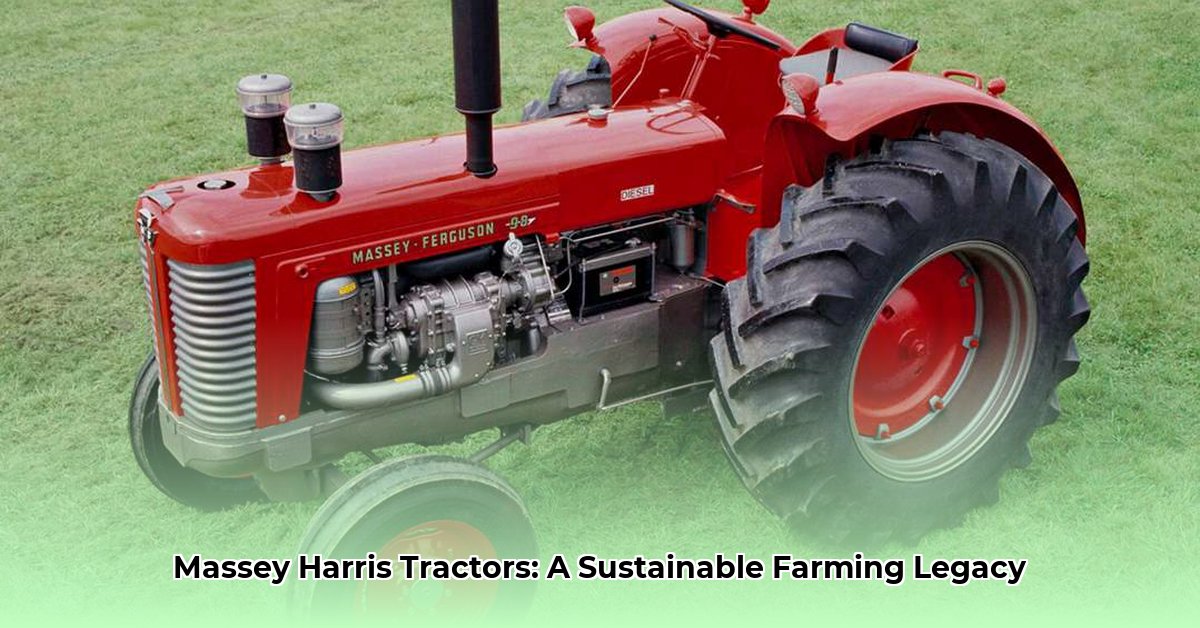
The story of Massey Harris tractors is more than just steel and gears; it's a compelling narrative of agricultural transformation, reflecting both remarkable progress and the persistent pursuit of sustainable farming. This journey through time explores these iconic workhorses and their enduring impact. For more images of early models, see this 1950s Massey Ferguson page.
From Humble Beginnings to Farming Powerhouses: The Rise of Massey Harris
Imagine a pre-tractor era – backbreaking labor, limited yields, and a slower pace of life. Early Massey Harris models, like the endearingly named Pony 812, revolutionized this reality. These relatively small, less powerful machines represented a giant leap from animal power, dramatically boosting efficiency, particularly for smaller farms. While not the behemoths of later years, they enabled farmers to accomplish significantly more each day. But how fuel-efficient were these early models? This question lies at the heart of their sustainability narrative. Comparing their fuel consumption to modern standards reveals a nuanced picture, with some historians suggesting surprising efficiency for their time, while others remain skeptical about their overall sustainability. Further research into this area is vital.
Horsepower, Progress, and the Environmental Footprint: A Closer Look
As technology advanced, so did the power of Massey Harris tractors. The 44 Special, for example, marked a substantial increase in horsepower. This translated to increased acreage tilled, more crops harvested, and ultimately, greater food production. However, this productivity came at a cost. Did this enhanced horsepower lead to disproportionately higher fuel consumption and emissions? This is where the sustainability discussion becomes complex. While increased output was a considerable benefit, the environmental implications, concerning fuel usage and potential pollution, demand careful consideration. Unfortunately, precise historical data on fuel efficiency for many older models is limited, hindering definitive answers. Ongoing research is crucial to address this information gap. What percentage of early Massey-Harris owners kept meticulous fuel consumption records? The answer, likely quite low, underscores the challenge in accurately assessing their long-term environmental impact.
Fuel Choices: A Glimpse into Early Sustainability Efforts?
Massey Harris didn't solely focus on horsepower; they experimented with diverse fuel types. Some models offered options including gasoline, diesel, and even liquefied petroleum gas (LPG). This fuel flexibility suggests a forward-thinking approach to energy diversity, a core principle in modern sustainable agriculture. But did this versatility translate into genuine environmental friendliness at the time? It's a multifaceted question. While offering choices was a positive step, the actual environmental effect depended heavily on the fuel source's sustainability and the engine's efficiency. Accurate assessment requires a detailed analysis of both available fuels and engine performance, acknowledging the technological limitations of the era.
Beyond the Machine: The Broader Impact on Farming and the Environment
The Massey Harris legacy transcends the machines themselves. These tractors transformed not just farming practices but the very fabric of agricultural life. Mechanization reshaped labor demands, economic systems, and the fundamental human relationship with the land. While increasing productivity, this mechanization introduced new environmental challenges. How did widespread tractor use impact soil health, water consumption, and pesticide/fertilizer reliance? These are crucial questions when evaluating the long-term environmental effects of these groundbreaking machines. The complete picture is complex, encompassing both benefits and drawbacks, prompting critical reflection on contemporary farming methods.
Massey Ferguson and AGCO: A Continuing Legacy of Innovation
The Massey Harris narrative extends beyond the original company name. Its merger with Ferguson, forming Massey Ferguson, and subsequent integration into AGCO, reflects a continuous pursuit of improvement within the agricultural machinery sector. These mergers represent a broader trend: the relentless evolution toward greater efficiency and, hopefully, enhanced sustainability in modern agriculture. Understanding the Massey Harris history provides valuable context for this ongoing evolution.
Working Towards a Greener Future: Research, Collaboration, and Action
To fully understand the environmental impact of early agricultural machinery like Massey Harris tractors, further investigation is necessary. Here are crucial steps forward:
Comprehensive Archival Research: Thorough examination of historical records, including service manuals, production data, and other documents, is crucial for uncovering vital information on fuel consumption, maintenance practices, lifespan, and manufacturing materials.
Collaborative Research Efforts: Cooperation between agricultural equipment manufacturers and researchers is essential. Joint analysis of older tractor designs can identify valuable lessons applicable to creating more sustainable machinery today.
Educational Initiatives: Farmers and landowners require access to this historical data for informed decisions about modern equipment. Understanding the past informs a more sustainable future.
Informed Policy Development: Policymakers must consider the long-term environmental effects of farm mechanization when formulating regulations, including incentives for energy-efficient equipment and responsible disposal methods. The entire life cycle of farm machinery has significant environmental implications that demand policy attention.
The Massey Harris legacy is rich and multifaceted, reflecting the progress and challenges inherent in transforming agriculture. By combining historical research with modern expertise and a cooperative commitment to sustainable practices, we can draw valuable lessons for the future. This path forward, informed by the past, paves the way for a more environmentally responsible and sustainable agricultural future.